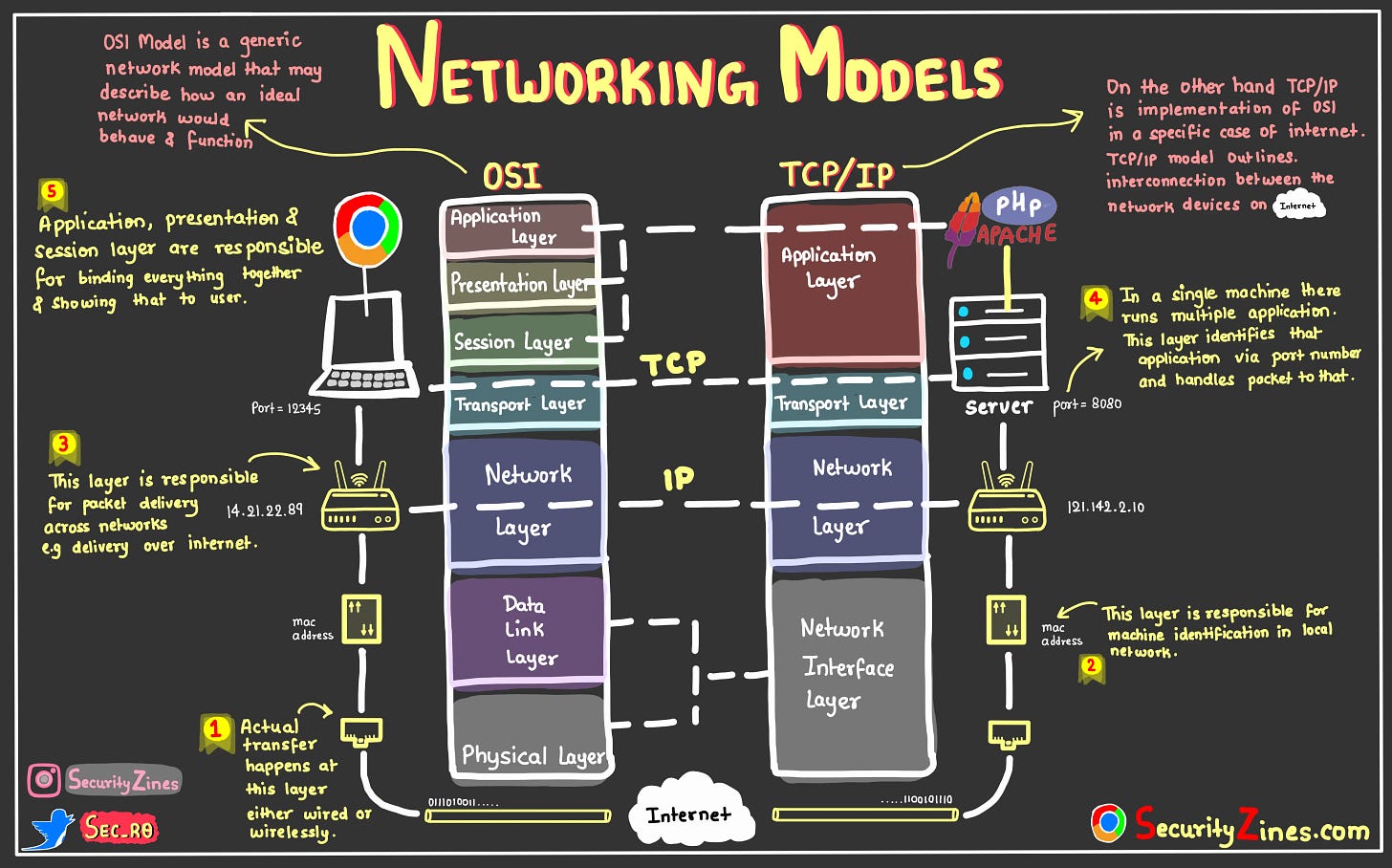Hey Folks,
We will learn about the networking models OSI and TCP/IP in this flyer.
The networking model explains how systems communicate with each other by describing the structure, parts, and design involved.This flyer will provide a comprehensive analysis of the different network layers found in both the OSI and TCP/IP networking models.
OSI Model
The OSI (Open Systems Interconnection) model is a conceptual framework that standardizes the functions and interactions of different protocols and networking components. It consists of seven layers, each responsible for specific tasks in the communication process.
To understand the OSI model, let's consider the example of sending a message from one computer to another over a network.
Physical Layer: This layer deals with the physical transmission of data. It ensures that the electrical, mechanical, and physical aspects of the communication are properly handled, such as converting the message into electrical signals and transmitting them through a cable.
Data Link Layer: This layer ensures reliable communication between directly connected devices. It organizes the data into frames, performs error checking, and handles access to the physical medium, like Ethernet.
Network Layer: This layer manages the addressing and routing of data packets across multiple networks. It determines the best path for the message to reach its destination by using IP addresses and routing protocols, like IP (Internet Protocol).
Transport Layer: This layer ensures the reliable delivery of data by dividing large chunks of data into smaller segments. It also handles flow control, error recovery, and reassembly of segments on the receiving end, using protocols like TCP (Transmission Control Protocol).
Session Layer: This layer establishes, maintains, and terminates communication sessions between applications. It manages synchronization, checkpointing, and recovery processes to ensure data integrity during the session.
Presentation Layer: This layer is responsible for data representation and encryption. It transforms the data format to be understood by the receiving application and handles tasks like compression and encryption.
Application Layer: This layer provides services directly to the end-users, such as file transfer, email, and web browsing. It interacts with the user and initiates communication requests.
By breaking down the communication process into these distinct layers, the OSI model helps ensure interoperability and standardization across different networking technologies and allows for the seamless exchange of information between systems.
TCP/IP Model
The TCP/IP (Transmission Control Protocol/Internet Protocol) model is a networking model used for communication between devices on the internet. It is a set of protocols that govern how data is transmitted, routed, and received across networks.
The TCP/IP model consists of four layers, each serving a specific purpose in the communication process:
Network Interface Layer: This layer deals with the physical transmission of data and the protocols used to connect devices to the network, such as Ethernet or Wi-Fi.
Internet Layer: The internet layer is responsible for addressing, routing, and fragmenting data packets for transmission across different networks. It uses IP (Internet Protocol) addresses to identify devices and determines the most efficient route for data transmission.
Transport Layer: This layer provides reliable and ordered delivery of data between devices. It uses protocols like TCP (Transmission Control Protocol) to establish connections, manage data flow, perform error recovery, and ensure that data is received in the correct order.
Application Layer: The application layer is where applications and services interact with the network. It includes protocols such as HTTP (Hypertext Transfer Protocol) for web browsing, FTP (File Transfer Protocol) for file transfer, and SMTP (Simple Mail Transfer Protocol) for email.
The TCP/IP model is the foundation of the internet, enabling seamless communication between devices and networks worldwide. It allows for the reliable transmission of data packets across different networks, ensuring that information reaches its intended destination accurately and efficiently.





